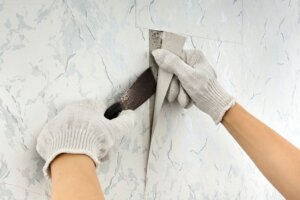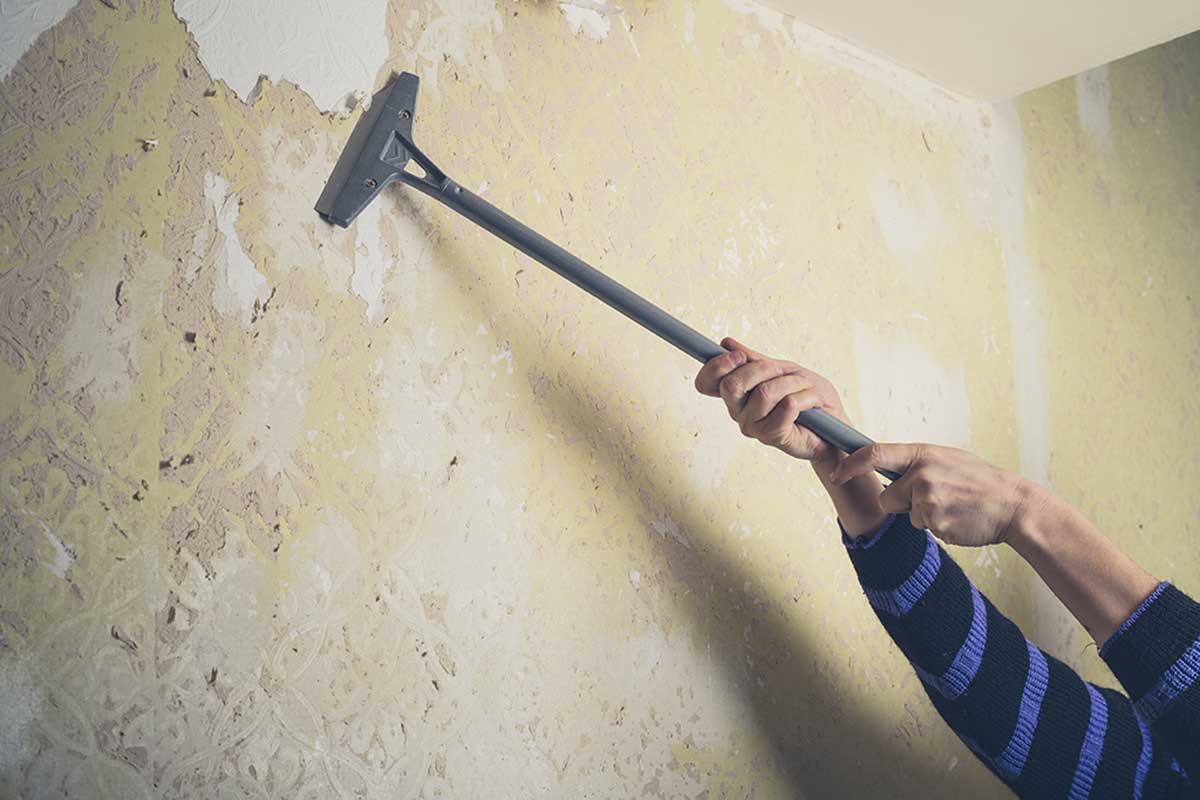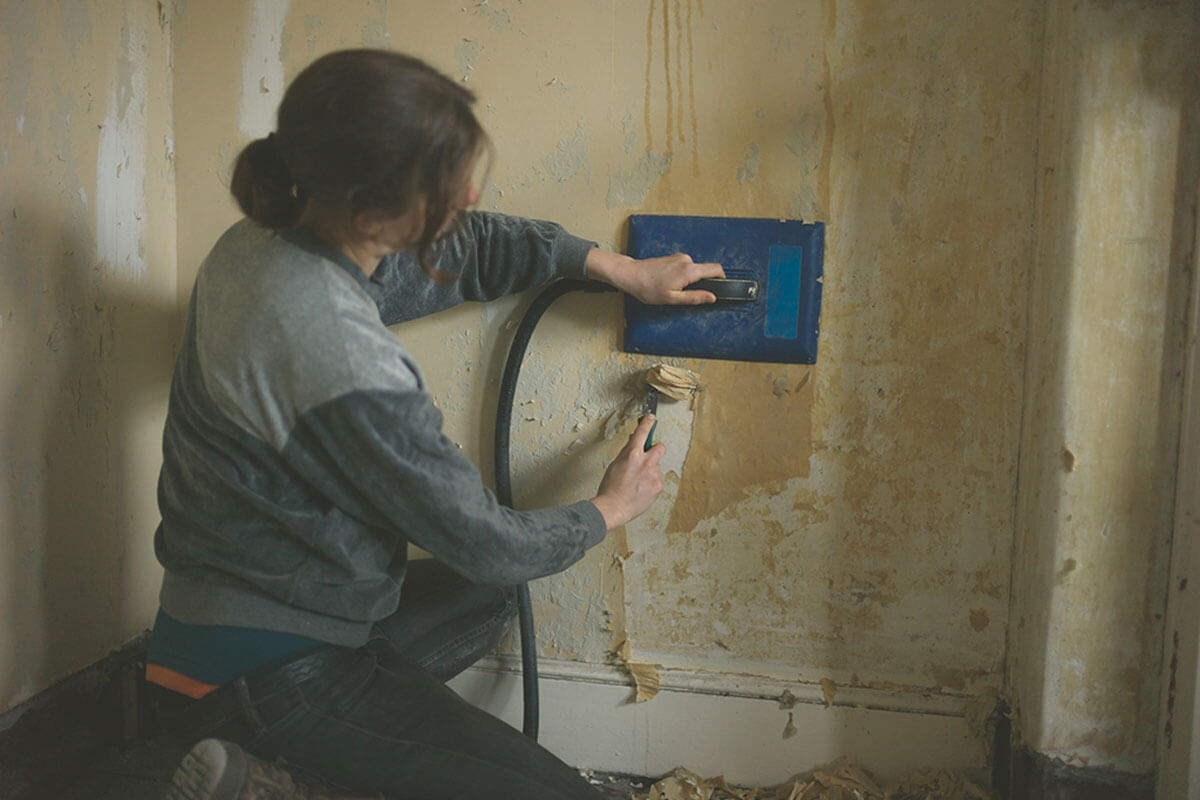4 Methods to Remove Old Wallpaper

Wallpaper is becoming increasingly common and fashionable in homes. This is because there are so many styles and types to choose from and it looks great in our home interiors. Therefore, it’s also important to know how to remove old wallpaper so that you can make changes as often as you desire.
In addition to removing old wallpaper to renew the appearance of your home, it’s also good to understand how you can repair damaged areas of wallpaper and keep it looking new. Read this article so you can put the best removal method into practice.
How do you remove old wallpaper?

If you want to remove old wallpaper from the walls of your home, it’s important that you prepare the room correctly. So the first thing you should do is remove any items or accessories that may be damaged or may hinder your access. Such is the case with pictures or decorative objects that are hanging on your wall. It’s particularly important to also disconnect any cables to avoid accidents.
Although removing old wallpaper is an easy process, it requires your complete attention to ensure that the final result looks good. It’s important that you don’t forcefully pull at the paper, as this makes the process more difficult. Patience, in this case, is essential.
Here are the four methods that’ll help you with this task:
1. Soapy water
The first method to remove old wallpaper is soapy water. The first thing you need to do is moisten the old wallpaper with enough water so that it softens. This will make it easier to remove. The wetter the paper is, the easier it’ll be to peel it off and avoid small pieces sticking together.
Now, in a container, mix water with a little laundry powder. Once the mixture is well combined, spread it on the wallpaper with the help of a roller. This will cause the paper to come apart in parts and you can begin removing it. Remove it from the bottom up.
2. Water with solvent
This process is very similar to the previous one. But instead of using soapy water, use water with a special solvent to remove old wallpaper. Trisodium phosphate (TSP) is the most popular and you can buy this in a specialized store.
Use hot water and add the mixture to a container or spray bottle. Follow the instructions on the product to find out how much of the solvent you need to use. Once ready, spray the mixture onto the old wallpaper and let it act for around 15 to 20 minutes before starting to remove it.
3. Steam

The third method for removing old wallpaper from your walls is steam. It’s a technique that’s often used when other methods have not worked as well. The reason is that not everyone has a steamer or access to one at home.
However, if you have a steamer at home or you have access to one, you’ll find that it’s a very easy technique to help you remove old wallpaper. The only thing you need to do is pour the water into the machine, pass it directly over the wallpaper and that’s it.
As with soapy water, the paper will soften and with the help of a scraper it’ll peel off with ease.
4. Products to remove old wallpaper
We finish with the fourth technique, which covers the use of special products to remove old wallpaper from the walls. The only thing you should keep in mind is that these are usually chemical-based products that must be handled with caution. Always wear a mask and gloves if you’re using this type of product.
These products are available in specialized stores and some are very easy to use. Some, for example, come as a spray and they must be sprayed directly onto the wall. Each product will have its own usage instructions and the specifications of the amount you’ll need to apply.
Tips for after removing old wallpaper
Once you’ve removed all the old wallpaper from the wall, you should follow a few simple tips to restore the surface and prepare it for decorating. The first thing you should do is wash the wall and then dry it with a dry cloth.
Before applying new wallpaper or painting the wall, the wall must be completely clean and smooth. Remove any traces of glue, paper, or blemishes. This way you’ll get a great finish.
Wallpaper is becoming increasingly common and fashionable in homes. This is because there are so many styles and types to choose from and it looks great in our home interiors. Therefore, it’s also important to know how to remove old wallpaper so that you can make changes as often as you desire.
In addition to removing old wallpaper to renew the appearance of your home, it’s also good to understand how you can repair damaged areas of wallpaper and keep it looking new. Read this article so you can put the best removal method into practice.
How do you remove old wallpaper?

If you want to remove old wallpaper from the walls of your home, it’s important that you prepare the room correctly. So the first thing you should do is remove any items or accessories that may be damaged or may hinder your access. Such is the case with pictures or decorative objects that are hanging on your wall. It’s particularly important to also disconnect any cables to avoid accidents.
Although removing old wallpaper is an easy process, it requires your complete attention to ensure that the final result looks good. It’s important that you don’t forcefully pull at the paper, as this makes the process more difficult. Patience, in this case, is essential.
Here are the four methods that’ll help you with this task:
1. Soapy water
The first method to remove old wallpaper is soapy water. The first thing you need to do is moisten the old wallpaper with enough water so that it softens. This will make it easier to remove. The wetter the paper is, the easier it’ll be to peel it off and avoid small pieces sticking together.
Now, in a container, mix water with a little laundry powder. Once the mixture is well combined, spread it on the wallpaper with the help of a roller. This will cause the paper to come apart in parts and you can begin removing it. Remove it from the bottom up.
2. Water with solvent
This process is very similar to the previous one. But instead of using soapy water, use water with a special solvent to remove old wallpaper. Trisodium phosphate (TSP) is the most popular and you can buy this in a specialized store.
Use hot water and add the mixture to a container or spray bottle. Follow the instructions on the product to find out how much of the solvent you need to use. Once ready, spray the mixture onto the old wallpaper and let it act for around 15 to 20 minutes before starting to remove it.
3. Steam

The third method for removing old wallpaper from your walls is steam. It’s a technique that’s often used when other methods have not worked as well. The reason is that not everyone has a steamer or access to one at home.
However, if you have a steamer at home or you have access to one, you’ll find that it’s a very easy technique to help you remove old wallpaper. The only thing you need to do is pour the water into the machine, pass it directly over the wallpaper and that’s it.
As with soapy water, the paper will soften and with the help of a scraper it’ll peel off with ease.
4. Products to remove old wallpaper
We finish with the fourth technique, which covers the use of special products to remove old wallpaper from the walls. The only thing you should keep in mind is that these are usually chemical-based products that must be handled with caution. Always wear a mask and gloves if you’re using this type of product.
These products are available in specialized stores and some are very easy to use. Some, for example, come as a spray and they must be sprayed directly onto the wall. Each product will have its own usage instructions and the specifications of the amount you’ll need to apply.
Tips for after removing old wallpaper
Once you’ve removed all the old wallpaper from the wall, you should follow a few simple tips to restore the surface and prepare it for decorating. The first thing you should do is wash the wall and then dry it with a dry cloth.
Before applying new wallpaper or painting the wall, the wall must be completely clean and smooth. Remove any traces of glue, paper, or blemishes. This way you’ll get a great finish.







